Orthodontic rubber bands, or elastics, may seem like a small part of your braces, but they play a vital role in aligning your bite and ensuring a successful treatment outcome. Understanding how often to change your rubber bands can make a significant difference in how efficiently your teeth move and how comfortably you progress through your treatment plan. Let’s explore what you need to know step by step.
Why are rubber bands used in orthodontic treatment
Rubber bands are not fitted for everyone with braces. They are usually prescribed in the middle or later stages of treatment to correct bite alignment problems such as overbites, underbites, and crossbites.
These elastics work by applying continuous pressure in specific directions to guide the teeth and jaw into their correct positions. The force they provide complements the work done by brackets and archwires.
Depending on your orthodontic needs, rubber bands might be attached in different configurations:
- Class II elastics: Typically used to correct an overbite
- Class III elastics: Often used for underbites
- Crossbite elastics: Placed diagonally to correct lateral misalignments
How often should you replace rubber bands on your braces?
You should change your orthodontic rubber bands at least 2–3 times a day, or every 12 hours, to maintain their effectiveness and ensure proper tooth movement. It’s best to follow your orthodontist’s specific instructions, but generally, you’ll want to replace them:
- After meals: Remove them for eating and replace with fresh bands afterwards.
- Before bed: Swap them out before going to sleep to maintain overnight pressure.
- After brushing: Always apply new elastics after cleaning your teeth.
- If they break: Replace them immediately to maintain consistent force.
The effectiveness of rubber bands depends on the tension they apply, which diminishes over time. Once they stretch out or lose their tension, they stop providing the necessary pressure to move your teeth.
Why change rubber bands frequently?
Orthodontic rubber bands lose their elasticity and strength with time. If not changed regularly, they won’t exert the necessary force to move your teeth effectively. This could:
- Delay treatment progress
- Lead to inconsistent movement and discomfort
- Result in longer overall treatment time
Wearing stretched or weakened elastics is as ineffective as not wearing them at all.
Signs it’s time to change your elastics
Knowing when your rubber bands need changing helps ensure continuous and effective tooth movement. Watch for these indicators:
- Loss of elasticity: If the bands feel loose or stretched, replace them.
- Discolouration: Dirty or stained elastics should be discarded.
- Breakage: Snapped bands must be replaced immediately.
These signs can occur sooner than expected, so keep spare elastics handy throughout the day.
What happens if you don’t change your rubber bands often enough?
Failing to replace your elastics regularly can slow down your orthodontic progress and prolong your treatment time. Rubber bands that have lost their tension become ineffective, allowing the teeth to settle into undesired positions.
You might also experience:
- Increased discomfort due to inconsistent pressure
- Risk of snapping and irritation
- Worsening of jaw misalignment if rubber bands are skipped or worn incorrectly
Inconsistent use can set your treatment back by weeks or even months. It’s not just about wearing them—it’s about wearing them properly and consistently.
When should rubber bands be removed?
Although rubber bands should be worn nearly full-time, there are instances when they should be removed:
- When brushing and flossing: This allows for thorough cleaning without obstruction.
- During meals: Unless advised otherwise, remove them while eating to prevent food from getting trapped.
- If directed by your orthodontist: In some cases, your orthodontist might ask you to temporarily stop using elastics to assess movement.
Always reapply a fresh pair immediately after these activities.
How long should you wear your elastics each day?
Unless your orthodontist advises otherwise, you should wear your rubber bands 24/7, except when eating, brushing your teeth, or replacing them.
Wearing them consistently throughout the day and night ensures that your teeth are under constant, gentle pressure, essential for effective movement.
Different types of rubber bands used for braces
Not all elastics are created equal. They come in various sizes and strengths, depending on what they need to achieve.
- Light, medium, or heavy force: Depending on the distance and direction of movement required.
- Different lengths: Longer elastics provide gentler pressure over a wider span.
- Coloured or clear: Mostly an aesthetic preference for patients.
The exact type and configuration will be tailored to your needs, and changes may occur throughout your treatment.
What to do if a rubber band snaps or falls off
Rubber bands are small and delicate, and it’s not unusual for one to snap during daily activities. If this happens:
- Remove any broken pieces still attached to your braces.
- Replace it immediately with a new rubber band.
- If breakage occurs frequently, inform your orthodontist. It may indicate an issue with fit or placement.
Always carry a few spare elastics with you to avoid delays in replacement.
Tips for managing discomfort when wearing elastics
Discomfort is common, especially when you start wearing rubber bands or switch to a new strength. Here are a few practical tips:
- Use orthodontic wax: Apply it to the brackets if they irritate.
- Stay on top of replacement: Old, stretched bands can tug inconsistently, causing more discomfort.
- Stick to soft foods during adjustment: Foods like yoghurt, pasta, and soups can ease the strain on your jaw.
- Warm salt water rinses: These can help reduce soreness in the gums and cheeks.
It usually takes a few days for your mouth to adjust. Persisting through the initial discomfort will lead to better long-term results.
Can rubber bands cause allergic reactions?
Yes, though rare, some patients may have a latex allergy, which can cause itching, redness, or swelling in and around the mouth.
If you suspect a reaction:
- Stop using the rubber bands immediately.
- Inform your orthodontist.
- Request latex-free alternatives, which are widely available.
Most orthodontic practices are well-prepared to accommodate allergies and sensitivities.
Does what you eat affect your rubber bands?
Certain foods can interfere with your elastics:
- Sticky foods (like toffee or chewing gum): These may cause elastics to stick and snap.
- Hard foods (such as nuts and raw carrots): Can apply extra pressure and dislodge rubber bands.
- Highly pigmented foods (like curry or berries): May stain clear elastics.
Sticking to a braces-friendly diet will not only protect your elastics but also keep your overall oral health in check.
How to make rubber band wear part of your daily routine
Creating a habit around rubber band replacement can improve treatment outcomes significantly:
- Change them after meals and brushing
- Keep extra elastics in your bag, locker, or pencil case
- Set phone reminders if you tend to forget
- Involve a parent or friend to keep you accountable, especially for younger wearers
Consistency in wear is often the defining factor between finishing treatment on time and dealing with delays.
Final Thoughts
Rubber bands might be small, but their impact on your orthodontic treatment is substantial. Changing them regularly, handling them correctly, and committing to the routine will ensure your treatment stays on track and is as short as possible. With consistent care, the result—a properly aligned, healthy smile—will be well worth the effort. For more information on orthodontic treatment and how we can help, contact us at Birchgrove Dental Practice.
References
https://www.healthline.com/health/dental-and-oral-health/braces-rubber-bands




